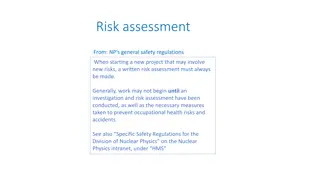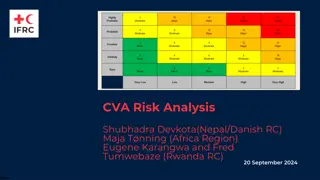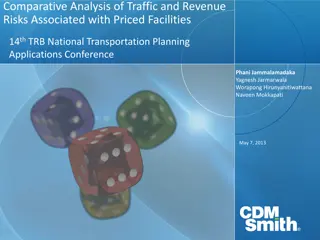Risk-Informed Systems Analysis (RISA) Projects and Value to the Industry
The Risk-Informed Systems Analysis (RISA) projects aim to optimize safety margins, minimize uncertainties, and achieve economic efficiencies while maintaining high safety levels in the nuclear industry. The projects focus on areas such as plant modernization, diversification of light-water reactors, development of analysis methods, materials research, physical security optimization, and evaluation of accident-tolerant fuel. By using a risk-informed approach, these initiatives enhance the safe, efficient, and economical performance of the nation's nuclear fleet, extending their operating lifetimes and offering benefits like economic gains and reduced fuel costs.
- Risk-Informed Systems Analysis
- Nuclear Industry
- Safety Margins
- Economic Efficiencies
- Plant Modernization
Download Presentation

Please find below an Image/Link to download the presentation.
The content on the website is provided AS IS for your information and personal use only. It may not be sold, licensed, or shared on other websites without obtaining consent from the author. Download presentation by click this link. If you encounter any issues during the download, it is possible that the publisher has removed the file from their server.
E N D
Presentation Transcript
RISK-INFORMED SYSTEMS ANALYSIS (RISA) Projects and Value to the Industry Lana Lawrence Svetlana.Lawrence@inl.gov PSAM-16 Conference June 2022 1
Light Water Reactor Sustainability Program (LWRS) LWRS Goal: Enhance the safe, efficient, and economical performance of our nation's nuclear fleet and extend the operating lifetimes of this reliable source of electricity Enableplant efficiency improvements through a strategy for long-term modernization Plant Modernization Flexible Plant Operation & Generation Enablediversification of light-water reactors to produce non-electrical products Develop analysis methods and tools to optimize safety and economics Risk Informed System Analysis Understand and predict long-term behavior of materials Materials Research Develop technologies to optimize physical security Physical Security 2
Risk-Informed Systems Analysis (RISA) Objective (the what) o R&D to optimize safety margins and minimize uncertainties to achieve economic efficiencies while maintaining high levels of safety Approach (the how) o Provide scientific basis to better represent safety margins and factors that contribute to cost and safety o Develop new technologies that reduce operating costs Areas of Expertise o Advanced modeling of physics-based phenomena Thermal-hydraulics, neutronics and reactor physics, risk-informed material degradation, uncertainty propagation o Advanced Data Analytics and Digital Modeling Diagnostic and prognostic analyses, resource optimization, AI/ML technologies, digital twins, uncertainty propagation o Probabilistic Risk Assessment (PRA) and Human-Reliability Analysis (HRA) RISA Framework 3
Evaluations of accident-tolerant fuel (ATF) with Higher Burnup Objectives: o Safety assessments of ATFs with increased enrichment and higher burnup (HBU) Specific focus of addressing Fuel Fragmentation, Relocation, and Dispersal (FFRD) issue o Support of regulatory approvals of HBU ATFs Risk-Informed approach is seen as the most likely pathway to regulatory approvals Benefits of HBU ATF Implementation: o Economic gains via extended refueling cycle o Reduced fuel costs due to better utilization of fuel in the reactor core o Reduced costs for spent fuel processing Image Credit: U.S. Department of Energy 4
Plant Reload Optimization Objectives: o All-inclusive integrated framework for fuel reload analyses o Optimization of core configuration to minimize new fuel volume Benefits: o 5-10% reduction in new fuel cost o Innovative core load analysis framework Traditional methods (developed decades ago) are labor-intensive and time-consuming o Explicit consideration of flexible power output operations o Framework supports ATFs, high burnup and longer cycle Since already transitioning to ATFs, why not implement more efficient reload analysis tools at the same time? Configuration of Reactor Core 5
Risk-Informed Asset Management Objectives: o Optimization of plant health monitoring and asset management to lower O&M costs o Provide information about system performance in clear and effective way Benefits: o Reduced O&M Costs Enhanced system performance Optimized plant resources o Reduced Capital Costs Effective reliability / ageing management o Support of decision-making processes related to system performance Data Models Decisions Methods Risk-Informed Asset Management Conceptual Framework Detailed information available to systems engineers and plant management Risk-Informed Asset Management: Integrated Processes 6
Risk Assessment of Digital I&C Systems Objectives: o Develop an integrated platform for risk assessments of Digital I&C Systems o Support Risk-Informed approaches Left:The NRC staff s plan to expand the current NRC policy for addressing CCFs Right: Risk-informed capabilities developed in RISA framework for risk assessment of digital systems. Benefits: o Potential elimination of the requirement for diverse systems to mitigate consequences of CCFs o An approach to evaluate various system architectures o Allows to find a Good Enough system design o Reduce efforts for validation and testing of safety-related DI&C systems 7
Risk-Aligned Data-Driven Inspections and Compliance Activities Objectives: o Automation of Corrective Action Program (CAP) o Use data to inform compliance activities o Development of equipment performance trends Benefits: o Significantly reduced manual labor o Performance trends provide valuable information to support compliance activates and risk-informed decision making Schematic of Workflow for CAP-Related Assessments 8
Dynamic Human Reliability Analysis Drag and drop procedure modeling Objectives: o Create a usable and adaptable standalone software tool for dynamic human reliability analysis (HRA) o Develop example applications and use cases to meet industry HRA needs Benefits & Accomplishments o Easy-to-use software tool built on plant operating procedures o Auto-calculation of performance shaping factors during scenarios o Coupling with RELAP5-3D for plant simulation o Demonstration of industry- relevant accident scenarios Dynamic calculation of performance shaping factors 9
lwrs.inl.gov 10























